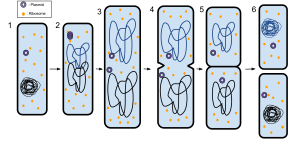Binary fission facts for kids
Binary fission means "dividing in half." It's a way that living things make copies of themselves without needing a partner. This is called asexual reproduction. It's super common for tiny, single-celled organisms like bacteria. Some single-celled eukaryotes, like the Amoeba and Paramecium, also use binary fission. During this process, a cell's genetic material, its DNA, gets copied and then shared equally.
What is Binary Fission?
In binary fission, a parent cell that has grown to its full size simply splits into two. First, it makes an exact copy of its DNA. Then, the cell divides into two new cells, called daughter cells. These daughter cells are usually exactly the same as the parent cell. They are like clones! Sometimes, a small change, called a mutation, can happen when the DNA is copied.

1. The bacterium before binary fission, with its DNA tightly coiled. 2. The bacterium's DNA has made a copy of itself. 3. The DNA copies move to opposite ends as the bacterium grows larger. 4. A new cell wall starts to form, beginning to separate the bacterium. 5. The new cell wall fully develops, splitting the bacterium into two. 6. The two new daughter cells each have their own coiled DNA, ribosomes, and plasmids.
The Simple Steps of Cell Division
During binary fission, the cell's main DNA molecule divides into two identical DNA molecules. The cell then starts to grow bigger. This growth makes space for each DNA molecule to move to opposite sides of the bacterium. At the same time, the cell membrane in the middle starts to pinch inward. This pinching creates two separate daughter cells. After they divide, these new cells grow and can then repeat the process themselves.
Binary Fission vs. Mitosis
Binary fission is a simple way for single-celled organisms to reproduce. It happens in eukaryotic cells too, but that process is much more complex. When eukaryotic cells divide, it's called mitosis. Mitosis involves many more steps and structures inside the cell.
Basically, binary fission is when a cell copies its DNA and then simply splits down the middle. This creates two new cells that are usually identical to the first one.

